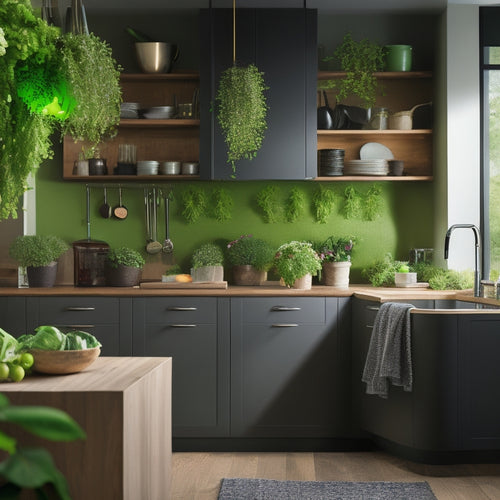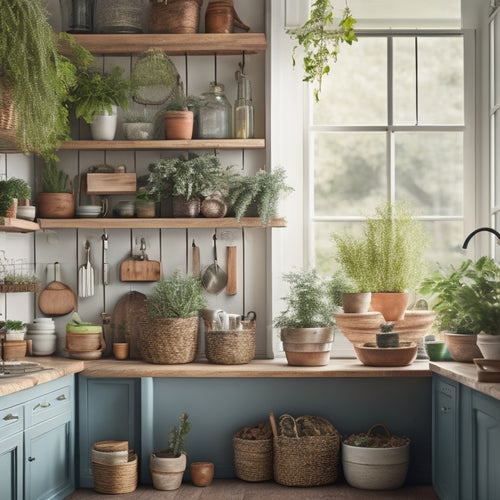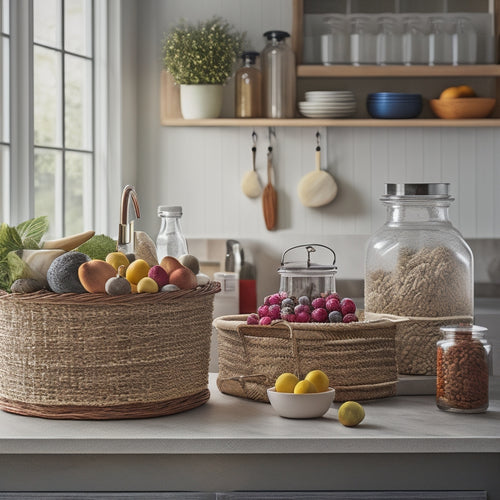
Innovative Cabinet Dish Drainer Installation Tips
Share
Installing a cabinet dish drainer can change your kitchen by maximizing space and enhancing organization. Start by measuring your cabinet dimensions to determine the best height for installation. Choose a design that employs vertical storage; this keeps dishes organized and off your counter. Opt for durable materials, like stainless steel, for longevity and low maintenance. Guarantee effective drainage by selecting a system that fits your kitchen setup. Don't forget to improve air circulation with adequate ventilation to prevent moisture buildup. There's a lot more to take into account that can boost your kitchen's efficiency and style.
What You Need to Know
- Optimize vertical storage by installing wall-mounted shelves or hanging racks for easy access to dishes and to maximize cabinet space.
- Ensure proper drainage by selecting a system that suits your kitchen layout, such as gravity or siphon drainage styles.
- Incorporate adjustable shelves and stackable baskets inside cabinets to enhance organization and simplify access to dishware.
- Use durable materials like stainless steel or aluminum for longevity, ensuring resistance to rust and corrosion.
- Promote air circulation by installing vents or leaving cabinets slightly ajar to prevent moisture buildup during drying.
Space-Saving Design Advantage
When you're tight on kitchen space, a cabinet dish drainer can be a game changer. By utilizing vertical storage solutions, you can keep dishes organized without sacrificing countertop space.
These racks not only enhance organization but also often come with multi-functional features that streamline kitchen tasks.
Plus, many models offer multi-functional features that enhance both storage and convenience, making your kitchen more efficient.
Vertical Storage Solutions
Vertical storage solutions offer a smart way to maximize your kitchen space, especially in areas where countertops are limited. By utilizing vertical accessibility, you can keep your kitchen organized without sacrificing style. Consider installing shelves or racks above your dish drainer. This not only enhances kitchen aesthetics but also frees up precious counter space.
Here's a quick comparison of vertical storage options:
| Storage Option | Benefits |
|---|---|
| Wall-mounted shelves | Easy access to frequently used items |
| Hanging racks | Keeps dishes organized and within reach |
| Vertical cabinets | Conceals clutter while maintaining style |
| Pegboards | Customizable and versatile storage |
Multi-Functional Features
Many homeowners appreciate the advantages of multi-functional features in their kitchen designs, especially when space is at a premium. A cabinet dish drainer isn't just a place to dry your dishes; it can serve multiple roles, enhancing both functionality and style.
For instance, consider incorporating elements from budget-friendly storage hacks that allow for additional organization in your kitchen. By opting for a drainer that integrates seamlessly into your cabinetry, you're embracing versatile usage that maximizes every inch of your kitchen.
Consider a design that incorporates shelves or hooks for utensils, or even a pull-out tray for additional storage. This approach keeps your kitchen organized and efficient without sacrificing aesthetic appeal.
You'll love how these features blend into your existing decor while providing the freedom to customize your space according to your needs.
When selecting your dish drainer, look for options that complement your kitchen's style. Whether it's a sleek modern finish or a more rustic charm, the right choice can enhance your kitchen's overall look.
Embracing multi-functional features not only simplifies your daily tasks but also adds a touch of elegance to your space. Ultimately, you'll create a kitchen that's both practical and visually pleasing.
Enhanced Kitchen Organization
To enhance your kitchen organization, think about optimizing your vertical storage space.
By using drawer dividers effectively, you'll create a more functional area that keeps everything easily accessible.
Incorporating adjustable shelves and stackable baskets can further maximize your space, simplifying your daily kitchen tasks.
This approach not only maximizes your space but also simplifies your daily kitchen tasks.
Optimize Vertical Storage Space
Maximizing space in your kitchen can convert chaos into harmony, making meal prep and cleanup a breeze. One effective way to achieve this is through vertical shelf optimization. By utilizing the full height of your cabinets, you can store more items without cluttering your countertops. If your cabinets don't quite fit your needs, consider cabinet height adjustment; this allows you to create the perfect space for your dish drainer and other essentials.
Here's a quick reference to help you decide how to optimize your vertical storage:
| Tip | Benefits |
|---|---|
| Install adjustable shelves | Customizable heights for items |
| Use tiered organizers | Improved visibility and access |
| Hang pots and pans | Frees up cabinet space |
| Store rarely used items | Out of the way, easily accessible |
Utilize Drawer Dividers Effectively
Efficient kitchen organization can greatly enhance your cooking experience, and utilizing drawer dividers is a smart way to accomplish this. By implementing effective drawer organization, you'll maximize space and minimize clutter.
Start by evaluating what you keep in your drawers; this will guide your divider placement. Consider integrating a drawer pullout system to further optimize storage and accessibility.
Choose dividers that suit your drawer dimensions and the items you store. If you've got utensils, consider adjustable dividers that can adapt as your needs change. For a tidy look, group similar items together—spatulas with spoons, knives with cutting tools. This not only saves time but also reduces stress while cooking.
Remember to make use of vertical space within your drawers. Tall dividers can help create sections without taking up too much room. When placing dividers, make sure you leave enough space for frequently used items to be easily accessible.
With a little thought and creativity, drawer dividers can alter your kitchen into a well-organized haven, allowing you the freedom to whip up your culinary creations without hassle.
Key Functional Benefits
When you install a cabinet dish drainer, you're not just adding a stylish feature; you're maximizing your kitchen's potential.
Its space-saving design helps you reclaim precious countertop real estate while keeping your dishes organized.
Additionally, by employing effective shelving solutions, you can further enhance your kitchen efficiency.
Plus, with improved drying efficiency, you'll find that your clean dishes are ready to use much faster.
Space-Saving Design Advantages
A well-designed cabinet dish drainer can alter your kitchen into a more organized and functional space. By utilizing vertical space, you can maximize your compact kitchen's potential. This efficient layout not only declutters your countertops but also enhances the overall aesthetics of your kitchen.
Here's a quick overview of the space-saving benefits:
| Benefit | Description | Impact |
|---|---|---|
| Vertical Storage | Keeps dishes off the counter, freeing up space | More room for food prep |
| Organized Dish Placement | Streamlines how you store and access dishes | Saves time when washing up |
| Multi-Functional Design | Can include drying racks and utensil holders | Reduces need for extra storage |
With these features, you'll find that your kitchen feels more open and inviting. You can enjoy the freedom of movement while preparing meals, making your cooking experience more enjoyable. Plus, with everything neatly stored away, cleanup becomes a breeze. Accept the space-saving design advantages of a cabinet dish drainer, and change your kitchen into a haven of efficiency and style.
Enhanced Drying Efficiency
With a well-designed cabinet dish drainer, not only do you optimize your kitchen space, but you also improve the drying process for your dishes.
You'll find that utilizing smart water evaporation techniques plays a vital role in ensuring your dishes dry quickly and effectively. Positioning your drainer at an angle allows excess water to flow away, promoting faster evaporation. Additionally, consider incorporating this kitchen storage tip to maximize vertical space, which can further enhance air circulation around your dishes.
Incorporating air circulation methods is equally important. By ensuring your cabinet has adequate ventilation, you create an environment where air can flow freely around the dishes. This helps prevent moisture buildup, which can lead to unpleasant odors and mold.
Consider adding small vents or leaving the cabinet slightly ajar after washing to increase airflow.
Additionally, investing in a dish drainer with a removable tray can streamline the drying process. It collects any leftover water, preventing it from pooling under your dishes and improving the efficiency of water evaporation.
Selecting Based on Drainage Style
When choosing a cabinet dish drainer, consider the type of drainage system that best suits your kitchen setup.
You'll want to think about how much space you have available for installation, as it can impact both functionality and aesthetics.
Selecting the right style can make a big difference in how efficiently your dishes dry and how your kitchen flows.
Types of Drainage Systems
Choosing the right drainage system for your cabinet dish drainer can make a significant difference in both functionality and aesthetics.
You've got a couple of popular options to evaluate: gravity drainage and siphon systems.
Gravity drainage is a straightforward approach. It relies on the natural pull of gravity to direct water away from your dishes, making it a low-maintenance option.
If your kitchen layout allows for it, this system can effectively keep your cabinet dry and clutter-free, giving you peace of mind while you wash your dishes.
On the flip side, siphon systems offer a more innovative take on drainage. These systems create a vacuum effect to pull water away, which can be particularly useful in tight spaces where gravity drainage mightn't be feasible.
While siphon systems can require a bit more installation effort, they often provide a more efficient drainage flow, keeping water from pooling around your dishes.
Ultimately, your choice should align with your kitchen design and personal preferences.
Space Considerations for Installation
Installing a cabinet dish drainer involves careful consideration of your available space, especially regarding the drainage style you've selected. To guarantee efficiency, start by evaluating your cabinet dimensions. Measure the height between your countertop and the bottom of the upper cabinets; this will help you determine the ideal installation height for your drainer. You want it to be accessible yet unobtrusive.
If you've chosen a traditional drainage style, make certain there's enough clearance for water to flow freely without pooling. Consider the depth and width of your drainer as well—this impacts how well it fits into your cabinetry.
If space is tight, opt for a compact drainer that maximizes vertical space. This way, you can still wash and dry dishes without sacrificing important storage.
Remember, leaving room for ventilation is essential to prevent moisture build-up, which can lead to mold or odors.
Lastly, verify that your drainage system aligns with your plumbing. You want a seamless installation that doesn't require extensive modifications to your existing setup. Taking these factors into account will lead to a successful installation that enhances your kitchen's functionality.
Durable Materials for Longevity
When choosing a dish drainer, consider the strength of the materials used, as it directly impacts longevity.
Stainless steel, plastic, and bamboo each offer unique benefits, but their durability varies considerably.
Material Strength Comparison
A sturdy cabinet dish drainer is crucial for maintaining both functionality and longevity in your kitchen. When selecting materials, you want to concentrate on durability and load capacity. Different materials offer varying strengths, which can greatly impact the efficiency of your dish drainer.
Here's a quick comparison of common materials used in dish drainers:
| Material | Material Durability |
|---|---|
| Stainless Steel | High - resistant to rust and corrosion |
| Plastic | Moderate - lightweight but can warp over time |
| Wood | Moderate - requires treatment for moisture resistance |
| Aluminum | High - lightweight with good resistance to corrosion |
Stainless steel and aluminum excel in material durability and can support heavy loads without bending or breaking. Plastic, while cost-effective, may not withstand heavy dishes over time. Wood offers a natural aesthetic but needs proper care to maintain its integrity.
Choosing the right material for your cabinet dish drainer not only enhances its load capacity but also guarantees it stands the test of time, giving you that freedom in your kitchen to focus on what really matters.
Frequently Asked Questions
Can I Install a Dish Drainer in a Small Kitchen?
Absolutely, you can install a dish drainer in a small kitchen! Consider space-saving solutions and design considerations to maximize efficiency. Creative placements can free up counter space while keeping your kitchen functional and stylish.
What Tools Are Needed for Installation?
While some tools might seem intimidating, you'll find that essential items like a drill, screwdriver, and measuring tape simplify your installation. Choose durable drainer materials and apply effective installation techniques for a seamless, functional kitchen upgrade.
Are There Specific Measurements for Different Cabinet Sizes?
Yes, specific cabinet dimensions matter. You'll want to follow installation standards that account for varying sizes. Measure carefully to guarantee a perfect fit, allowing you the freedom to create a functional and stylish space.
How Do I Clean and Maintain My Dish Drainer?
To clean and maintain your dish drainer, use gentle cleaning techniques with suitable dish drainer materials. Regularly wipe it down with a soft sponge and mild soap to prevent buildup and maintain its shine. Enjoy your freedom from clutter!
Can Dish Drainers Be Customized for Unique Cabinet Designs?
Absolutely, you can customize dish drainers for unique cabinet designs. By incorporating custom designs, you'll achieve ideal space optimization, allowing your kitchen to reflect your style while maximizing functionality and efficiency. Welcome your creativity!
Explore More
Incorporating an innovative cabinet dish drainer is like adding a secret ingredient to your kitchen recipe—transformative and essential. It maximizes space, enhances organization, and offers functional benefits that make your daily routine smoother. Choosing the right drainage style and durable materials guarantees your drainer stands the test of time, just like a trusty kitchen tool. So, welcome these tips, and watch your kitchen evolve into a more efficient and inviting haven where every dish finds its perfect place.
Related Posts
-

Rechargeable Under-Cabinet Lighting for Sustainable Kitchens
Rechargeable under-cabinet lighting is ideal for your sustainable kitchen. You'll enjoy energy efficiency with LED te...
-

Countertop Storage Ideas for Small Kitchens
If you're looking to maximize your small kitchen, creative countertop storage solutions can make a big difference. Em...
-

Countertop Storage Ideas for Busy Homeowners
As a busy homeowner, optimizing your kitchen countertop is essential for efficiency and style. Consider using vertica...


